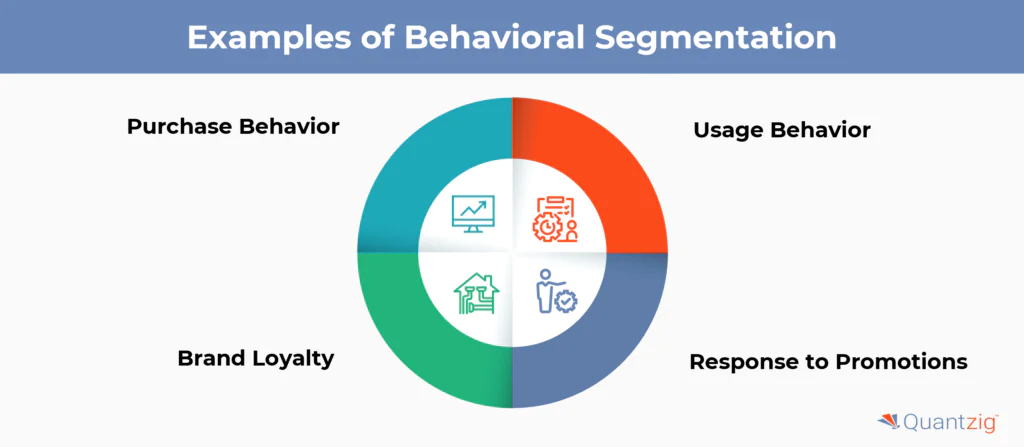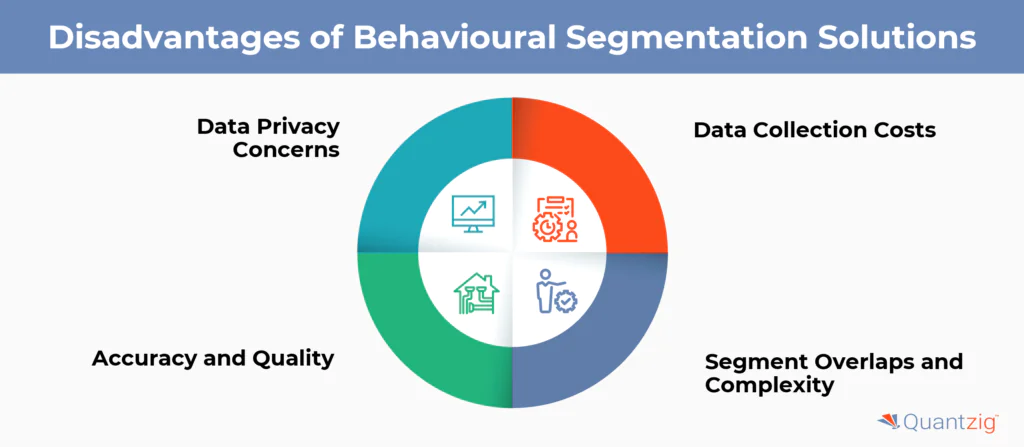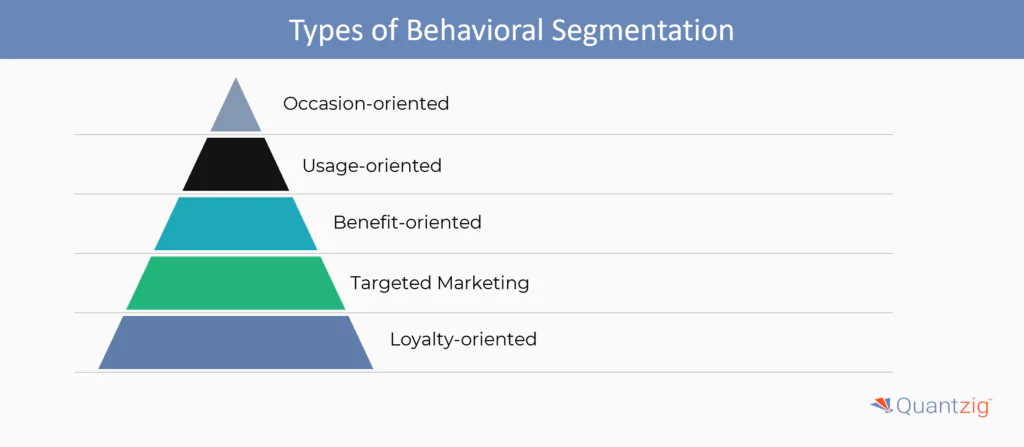Table of Contents
Overview of Behavioral Segmentation Solutions
If you’re a savvy marketer, business owner, or industry enthusiast, buckle up for a game-changing ride into the realm of Behavioral Segmentation! In this highly dynamic fast-food industry landscape, behavioral segmentation, an effective strategy groups your business clients based on how they act or when they connect with a website or business.
So, if you are looking for a solution using data analysis to better understand your target audience based on their specific demands, explore Quantzig’s advanced analytics solutions. Our analytics experts segment audiences based on their unique preferences and actions, empowering businesses with tailor strategies, and precision, driving maximum impact and ROI.
Book a demo to experience the meaningful insights we derive from data through our analytical tools and platform capabilities.
Request a demoWhat is Behavioral Segmentation?
Now, let’s unravel the mastery of Behavioral Segmentation – a strategic paradigm that categorizes consumers based on nuanced behaviors, actions, and interactions with products or services, using data analysis. This sophisticated strategy meticulously examines purchasing patterns, brand loyalty, product usage, and decision-making processes. By analyzing these behaviors, businesses can tailor their relevant advertising campaigns and offerings to effectively target and meet the specific needs and preferences of each segment.
The result? A potent formula for elevating client engagement, and satisfaction, and ultimately, improving sales volumes, and brand loyalty.
Characteristics of Behavioral Segmentation Solutions
Among the key characteristics of behavioral segmentation are the following:
- Organizations use this process to focus their efforts on the proper audience based on their purchasing behavior as shown by data analysis.
- Enables informed decisions based on the usage of resources such as budget and time to have a long-term impact on their consumers.
- It is based on the consumers’ attitudinal history to address and influence their future purchasing behavior decisions.
- You can also identify similar types of behaviors among your consumers and focus on your promotional efforts on a specific group.
- It can be adapted to the personality of each consumer group to achieve the established objectives.
- It allows the strategy’s creation to obtain loyal customers for the brand.
How can the Fast-Food Industry Reap the Advantages of Behavioral Segmentation Solutions?
In a landscape where consumer preferences are as diverse as the menu offerings, fast-food giants must not just cater to appetites but also anticipate desires. With competition in the fast-food sector fiercer than ever, comprehending the nuances of your customer base is the key ingredient for long-term prosperity. Integrating behavioral segmentation into their business approaches empowers fast-food enterprises to pinpoint their target demographic more precisely and enhance their menu selections. Here are several notable benefits of employing this analytical tool within the fast-food domain:
| Key Points | Details |
|---|---|
| Dietary Choices | Track changing dietary trends (organic, gluten-free) and adapt menus accordingly. |
| Track the Takeaway | Monitor dine-in vs. takeaway customers; add grab-and-go options if takeaways increase. |
| Target Specific Groups | Segment customers by age, gender, and demographics to tailor products and ads. |
| Easier Marketing Strategy Creation | Use segmentation to understand purchase behaviors and create targeted marketing strategies. |
| Make Predictions and Plan Ahead | Analyze client behavior to plan advertising, product updates, and counterstrategies. |
| Personalized Marketing | Tailor campaigns based on consumer preferences (e.g., promoting vegetarian options to health-conscious customers). |
| Menu Optimization | Optimize menus by analyzing preferences (e.g., introduce spicy items for spicy food lovers). |
| Retention | Identify loyal customers and offer personalized rewards to encourage repeat business. |
| Monitor Performance and Make Predictions | Use data to predict trends, monitor performance, and refine strategies and services. |
| Forward Planning | Understand audience behavior to optimize timing and product development, personalize outreach. |
| Actionable Insights into Consumer Behavior | Leverage behavioral segmentation for informed decisions, personalized content, and product innovation. |
Experience the advantages firsthand by testing a customized complimentary pilot designed to address your specific requirements. Pilot studies are non-committal in nature.
Request a pilot nowDisadvantages of Behavioral Segmentation Solutions
Behavioral segmentation, while a valuable tool in market research and targeting, is not without its disadvantages. Understanding these drawbacks is crucial for businesses aiming to deploy effective marketing strategies.
| Challenge | Description |
|---|---|
| Data Privacy Concerns | Customers may feel uneasy about data collection on their dining habits. Businesses must ensure compliance with GDPR, CCPA, and maintain trust. |
| Data Collection Costs | Implementing data systems can be expensive, especially for small F&B businesses, requiring investments in technology and personnel. |
| Accuracy & Quality | Inaccurate or biased data can lead to poor decision-making and ineffective strategies, requiring constant validation. |
| Segment Overlaps & Complexity | Consumers may belong to multiple segments, making precise targeting difficult and increasing resource demands. |
Examples of Behavioral Segmentation Solutions

It is a method used by marketers to categorize a target audience based on their actions, interactions, and behaviors, allowing for more effective strategies. Four common types of behavioral segment examples include:
- Purchase Behavior – Classifies buyers as frequent, occasional, or non-buyers to tailor marketing efforts. Frequent buyers get loyalty rewards, while occasional ones receive promotional nudges.
- Usage Behavior – Segments users as heavy, moderate, or non-users to personalize engagement. Heavy users get recommendations, while non-users receive re-engagement offers.
- Brand Loyalty – Distinguishes between loyal advocates, occasional patrons, and brand switchers to enhance retention. Loyal customers get exclusive perks, while occasional patrons receive incentives.
- Response to Promotions – Categorizes customers as coupon enthusiasts, price-sensitive shoppers, or non-responders to optimize marketing. Discounts target deal-seekers, while competitive pricing appeals to price-sensitive buyers.
These segmentation strategies—Occasion-Based, Benefit-Based, User Status, Usage-Based, and Loyalty-Based—help businesses enhance engagement, boost loyalty, and maximize ROI.
Get started with your complimentary trial today and delve into our platform without any obligations. Explore our wide range of customized, consumption driven analytical solutions services built across the analytical maturity levels.
Start your trial nowWhat are the Types of Behavioral Segmentation Solutions?
This is a powerful strategy that categorizes users into distinct smaller groups based on their actions, behaviors, and interactions with products or services. Let’s dive into few of the types:
- Occasion-Oriented Segmentation: Targets consumers based on specific events, such as lunch breaks or late-night snacks, allowing fast-food chains to create tailored promotions and enhance customer loyalty.
- Usage-Oriented Segmentation: Focuses on how customers engage with fast food, such as on-the-go meals or drive-thru convenience, enabling brands to optimize marketing and loyalty programs.
- Benefit-Oriented Segmentation: Identifies customer needs, such as healthier options, and tailors offerings to preferences like organic, vegetarian, or gluten-free choices to drive engagement.
- Targeted Marketing & Personalization: Uses customer data to deliver personalized promotions, increasing engagement and marketing efficiency through tailored offers.
- Loyalty-Oriented Segmentation: Rewards repeat customers with exclusive incentives, fostering retention and leveraging data-driven insights for optimized loyalty programs.
Behavioral segmentation helps fast-food brands enhance customer satisfaction, boost loyalty, and drive business growth by tailoring strategies to specific consumer needs and behaviors.
Quantzig’s Expertise in Behavioral Segmentation Solutions
Quantzig’s behavior segmentation solution is a powerful tool that enables businesses to gain deep insights into purchasers’ behavior and preferences. By analyzing vast amounts of datasets, this solution helps companies identify distinct segments and base their customer segmentation based on their actions, interests, and purchasing patterns. With this information and integrating AI (Artificial Intelligence), businesses can tailor their strategies, personalize experiences, and optimize product offerings to meet the specific needs of each segment. Our solution empowers businesses to make informed decisions, enhance client satisfaction, and drive revenue growth. With its advanced capabilities, businesses can include marketing automation and stay ahead of the competition and achieve a competitive edge in today’s dynamic market.
Experience the advantages firsthand by testing a customized complimentary pilot designed to address your specific requirements. Pilot studies are non-committal in nature.
Request a pilot nowConclusion
In conclusion, market researchers play a pivotal role in understanding consumer behavior within the F&B sector, aiding in informed purchasing decisions and customer segmentation. Utilizing behavioral segmentation and incorporating AI (Artificial Intelligence), enables businesses to create a Content Index tailored to diverse demographic preferences, thereby refining marketing strategy and addressing specific customer needs.
This approach fosters customer loyalty through personalized experiences, optimizing conversion rates, and facilitating product development. However, challenges such as resource allocation and content privacy concerns necessitate a balanced approach. Successful implementation requires navigating complexities while adhering to regulations, ensuring data integrity, and managing multiple segments effectively.








